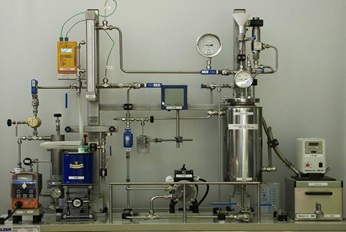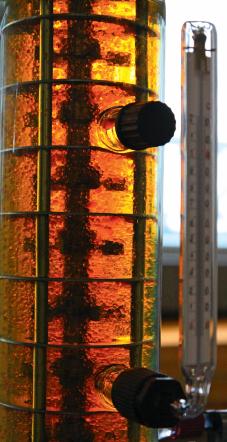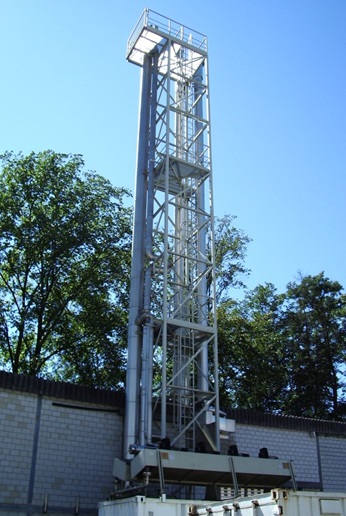- Process development and feasibility studies
- Mini-plant trials
- Pilot trials
- Documentation, test reports
- Measurement of physical properties
- Production of test samples for customer validation
Pilot plant testing
Pilot testing reveals the feasibility of separation processes
- Distillation and absorption
- Film evaporation
- Liquid-liquid extraction
- Crystallization
Test centers
The equipment in our test centers covers the whole range of unit operations that can be supplied to our customers. Our analytical laboratory equipment enables us to measure and monitor the relevant quantitative and qualitative parameters in order to ensure that the required specifications can be met.
Our modern test facilities are continuously upgraded and expanded. All our pilot plants are highly automated and allow complete logging of all relevant test parameters.
- Laboratory and pilot size equipment for all separation technologies
- Test halls of 3 000 m3, with up to 15 m useable height, explosion proof zone 1
- Process control system (S7 PLC with WinCC visualization and Hitec-Zang LabVision)
- Laboratories for bench scale tests and analyses: 200 m2
- Heating systems from 20 to 320°C
- Cooling systems from –20 to 100°C
- Vacuum down to 10-3 mbar (0.1 Pa)
Distillation and absorption
Distillation and absorption are well established separation technologies, and column performance can usually be accurately predicted by theoretical models. In many cases, however, tests are still recommended, for example for:
- Mixtures with impurities or by-components (for example, salts)
- Foaming systems or products containing solids
- Systems with an unknown (and not measurable) vapor-liquid equilibrium (VLE)
- Extreme requirements (related to, for instance, very high product purity)
- Processing of sensitive products in term of color, smell, or taste
Test procedure
Tests are usually carried out on the basis of results from simulations or clients’ data. The column is configured according to the process requirements (continuous operation, batch, total reflux). The sensitive parameters are varied during the test:
- Type of internals, tray height, number of stages
- Position of feed and side streams
- Feed flow
- Operating pressure
- Reflux ratio
Testing Equipment
Depending on the test plant, the temperature can be adjusted up to 320°C and the pressure from 1 mbar to 16 bar. Throughput ranges from 1 kg/hr to several hundreds of kg/hr.
- Column sizes:
- Glass: Ø 50 mm
- SS316L: Ø 100, 250 mm - Up to approximately 100 theoretical stages
- Internals: structured packing, slit trays
Film evaporation
In many cases it is not possible to accurately predict film evaporation performance from first principles, especially when the products are temperature-sensitive or viscous. Tests are therefore carried out to:
- Examine flow and wetting characteristics
- Evaluate and optimize evaporator type
- Determine optimum achievable concentrations (often on ppm level)
Test procedure
Tests are set up based on the first results using a rotary evaporator, on estimates of partial pressures, or on customer’s data. After selection of the type of evaporator, the test parameters are established:- Operating pressure / feed flow
- Recirculation ratio
- Cocurrent/countercurrent
- Stripping gas
- For wiped film evaporators:
- Wiper geometry
- Product take-off system
Testing equipment
The pilot plants can be operated with temperatures ranging from 20 to 320°C and pressures from 0.01 to 1 000 mbar (1 Pa to 100 000 Pa). Feed rates are between 0.5 kg/hr and about 200 kg/hr.- Rotary evaporator: 1 lt (0.001 m3)
- Flash evaporator: Ø 250 mm (0.250 m)
- Falling film evaporators:
- In glass: 0.12 m2
- In SS316L: 0.4, 0.8, 1.2 m2 - Wiped film evaporators:
- In glass: 0.025 m2, 0.06 m2
- In SS316L: 0.14 m2 - Short path evaporators:
- In glass: 0.05 m2
- In SS316L: 0.14 m2
Liquid-liquid extraction
Tests are normal practice for countercurrent extraction. An additional difficulty here is the complex scale-up of most extractors. Tests are necessary for the following reasons:
- Feasibility study (to investigate dispersion, droplet size, and phase separation)
- Evaluation and optimization of extractor type, and phase ratio
- Measurement of achievable concentrations
Test procedure
The selection of the solvent is the first step and determines the feasibility of the extraction process. Pilot trials are based on physical properties and equilibrium data. If necessary, mini-plant tests with recycle streams are carried out first to check the accumulation of impurities. Whenever possible, tests are performed on small extractors, with small feed samples. Typical test parameters are:- Internals (geometry, number of stages), energy input
- Loading, phase ratio
- Turn down
Testing equipment
Tests are usually carried out at temperatures between 20 and 100°C and at normal pressure. Feed rates range from 1 kg/hr to 300 kg/hr.- Extractor types:
- Agitated Kühni column ECR
- Sulzer packed column ECP
- Mixer-settler-column ECMS
- Mixer-settler EMS - Up to 20 theoretical stages
- Columns
- Sizes Ø 32, 60, and 150 mm
- Material: glass/PVDF, SS316L, hastelloy, titanium - Mixer-settler batteries:
- In glass: 250 ml (250x10-6 m3), 5 lt (0.005 m3)
- In SS316L: 80 lt (0.080 m3)
Crystallization
Crystallization is often used because of the advantage for high-purity separation of a substance. Data obtained from pilot trials are mandatory for the design and sizing of crystallization units. These pilot tests allow for optimization of the crystallization process with respect to the unit(s) to be employed. In the cases of new separation problems, where no experience with crystallization is available, bench scale tests are employed to check the feasibility of the separation.Test procedure
Between 2 and 10 kg of sample material are sufficient to carry out bench scale tests for a preliminary assessment on crystallization behavior, product quality and process feasibility. For pilot scale tests 100 to 800 kg are required. As a result of these investigations, a detailed proposal can be submitted, which will include a preliminary process flow diagram, an equipment list, and plant performance data.Testing equipment
- Falling film crystallizers (with 1, 4, 12 and 18 m height)
- Static melt crystallizers (1, 1.5, 6, 40 and 67 lt / 0.001, 0.0015, 0.006, 0.040 and 0.067 m3)
- Freeze concentration and suspension crystallizer with wash column
Analyses
For the evaluation of tests simultaneous analyses of samples are essential. Existing customers’ methods are used, or adapted when necessary. Modern, computer-controlled analytical equipment is available in-house in our test centers. For special analytical requirements, we cooperate with competent contract laboratories.
In-house analytical equipment
- GC (FID, TCD), Headspace GC, GC-MS
- HPLC with UV or RI detector
- UV-VIS spectroscopy
- Acidimetric and Karl-Fischer titration
- pH, conductivity
- Refraction index


